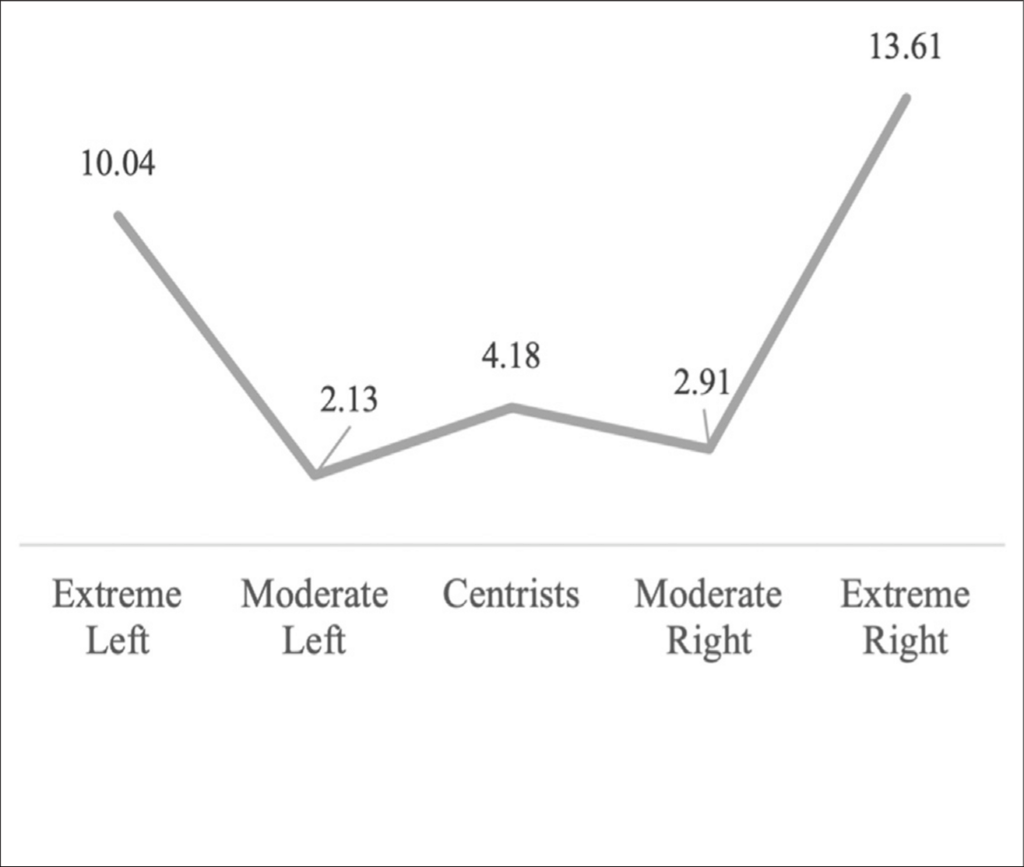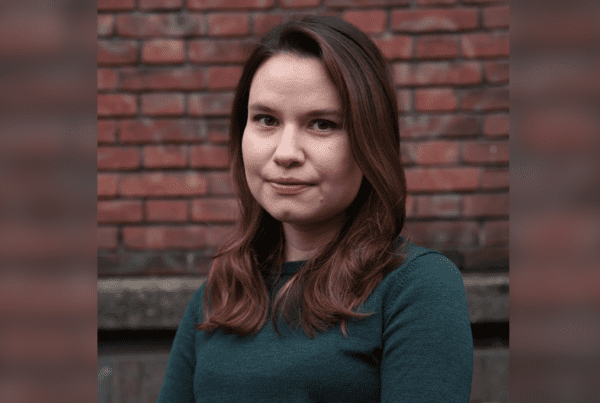Hilary, you recently published with your Brown University doctoral student, Svenja Kopyciok an article on left-wing xenophobia in Europe and, counter-intuitively, you found a surprisingly large share of those who identify as far left do express extremely xenophobic attitudes. Could you tell us more about your findings?
Indeed. Our analysis of European Social Survey data broke down anti-immigrant sentiments by ideological disposition along the conventional right vs. left dimension, which revealed something unexpected, at least for social scientists – that there are some people who identify with the far left who express anti-immigrant feelings. Not as many as on the far right, of course, but there are also some on the extreme left who oppose immigration or think that immigrants make their country of residence a worse place to live (see our graph of “Percentage of Extremely Anti-Immigrant Respondents by Political Ideology”).
We then profiled the far-left xenophobes in contrast to far-right xenophobes, speculating that they have different motives for these attitudes. Although we hypothesized that far-left supporters may view immigrants more as economic competitors or unfair exploiters of the welfare state than as cultural threats, we found that some of them shared with the far right such nationalist reasons for opposing immigrants. This reality opens up an opportunity for far-left parties, like the residual communist parties in Southern Europe, to adopt anti-immigrant policies to try to retain their loyal voters and compete with the far right.
As Emmy Eklundh commented in an earlier Agora posting, “within the European populist left, there is a very strong commitment to the European nation-state order: nationalist identities are seen as vehicles through which to further the progressive political struggle… You would think that left-wing thought is based around equality, but it may sometimes embrace differentialism, too.”

How would you explain that relationship between political orientation and xenophobia is not linear as often assumed, but curvilinear with the extremes being more xenophobic than those in between?
Our data disconfirmed most of the demographic explanations for the curvilinear relationship. Xenophobia is pretty widespread. Surveys have found that anti-immigrant or anti-immigration sentiments rose in the 1980s in most EU countries, around the rise of the modern far right. By then, according to Michael Minkenberg, over half the population felt there were too many people of another nationality living in their country. Although a minimal definition of the extreme right usually includes xenophobia and immigration, attitudes of intolerance do not correlate strongly with voting for radical right parties. Those voters may be motivated by other things, like culture or religion.
Illiberalism comes in many guises. Communist regimes have been autocratic and persecuted minorities. Extremism, intolerance, and authoritarian pursuit of order, obedience and conformity look the same to the victims, whatever the ideology. Populism is slightly different, but populist attitudes are likewise found on the left and right. Parties like SYRIZA and Podemos that won power in response to EU austerity policies fit the picture of populist parties of the left. Populism is sometimes defined as distrust of elites and democratic institutions. We found some support for the role of distrust on anti-immigrant sentiments. Generalized distrust is related to a lack of “social capital.” Alienated people who do not participate in civic life or encounter diverse others may demonize strangers.
Intense in-group feeling establishes strong boundaries between “us” and “them.” Xenophobia has long been associated with ultra-nationalism and the myth of a homogeneous or indigenous people. Those are not the exclusive attributes of the far right. For example, in December 2018, the European Union Agency for Fundamental Rights asked European Jews who was responsible for the most serious incident of anti-Semitic harassment they had experienced: Only 13 percent said it was someone with a far-right political view, while 30 percent said it was an “extremist Muslim” and 21 percent said it was someone with left-wing views.
But individual prejudices and discrimination are haphazard unless stimulated, organized, and expressed politically. White supremacists existed in the United States long before Trump came along and activated them. Likewise, far-left populist leaders have opportunistically played the “foreigner card” just as the far right has. Hostility to foreigners is often targeted at particular scapegoats, like groups of vulnerable immigrants or those who differ in appearance or religion. Therefore, a country’s party structure and leadership will also influence and condone pre-existing negative attitudes towards specific foreigners or even invent new ones. Our study admittedly did not explore contextual effects like party systems, discourse, or welfare effort. It also did not control for individual contact with immigrants, something that we sociologists take seriously but could not examine with this dataset. Social psychologists argue that normal interaction between in- and out-groups reduces prejudice.
So should we speak about a welfare chauvinism on the left too, not based on ethnic motives but on economic/material factors? Should we talk of a leftist xenophobia as an answer to neoliberal globalization and its cheap labor policies?
Many on the left would oppose “any type of horseshoe theory that says that extremism looks the same wherever you turn,” as Eklundh put it. We looked for ways to distinguish left and right. We were surprised that welfare chauvinism, measured by agreement that “immigrants should never be granted social rights,” could not account for left xenophobia as opposed to its right-wing counterpart. Prior research with the European Social Survey has found that perceived cultural threats are stronger motivations of voting preference for the radical right than perceived economic threats. Yet, we found the familiar curvilinear pattern of xenophobia along the left-right dimension held for welfare chauvinism, higher among the extreme left than the moderate left and highest among the extreme right. This is not to say that those who identify as left are as chauvinistic about welfare as the right are, but we found relatively high support for redistributive measures among the xenophobic far right as well as far left xenophobes. Egalitarianism did not differ, either.
We found the familiar curvilinear pattern of xenophobia along the left-right dimension held for welfare chauvinism, higher among the extreme left than the moderate left and highest among the extreme right.
One way to explain the difference between voting and xenophobia is that both poles of the political spectrum feel they deserve to hoard welfare measures for themselves, but for different reasons, say, prior contributions vs. nationality. We thought that the left xenophobes would want to exclude foreigners from welfare rights because benefits are contingent on lifelong taxpaying and contributions won through union struggles, not for cultural reasons. We don’t have enough specific data on this. There also seems to be a greater populist backlash against globalization and European integration at both ideological extremes. It is difficult to distinguish this from fear and distrust of foreigners.
What does this tell us about the transformations of the notions of ‘right’ and ‘left’ in today’s Europe?
Using the terms ‘right’ and ‘left’ to denote political parties and ideologies has always been ambiguous shorthand for what signified preference for capitalism or socialism. From the onset of mass democracy, political parties were arrayed along social class lines, with conservatives preferring a status-based electorate opposed by workers whose parties demanded and won inclusion in the body politic. The great wars of the 20th century cemented mass citizenship that, in the Cold War era, became a conflict between liberalism and socialism, as two social, political, and economic orders competing on the world stage and in democratic party systems.
The decomposition of the left and right is extreme in France and Italy, but even Sweden is experiencing partisan instability undermining social democratic coalitions. Immigration issues add to the stress on party systems.
By the collapse of the Soviet Union, however, this cleavage was sharply crosscut by so-called “post-materialist” conflicts over the environment, consumption, religion, and women’s, LGBTQ, racial and ethnic group identities, fragmenting the old ‘right’ and ‘left’ coalitions. Some even see the rise of the extreme right as a reaction to the rise of these New Left issues. While people can still place themselves along a right/left scale, the meaning of these terms vary by country, time period, party systems, and issues. In multi-party systems, the large, catchall “people’s” parties broke up and lost support to new Green and far right populist parties. The latest election in Germany is a case in point: the SPD – or alternatively, CDU – must now share power with the liberals and Greens unless they breach the firewall so far excluding the extreme right AfD. In the US and UK, this conflict is internalized within the two large parties. American progressives and moderate Democrats confront conservatives and Trumpist populists. The decomposition of the left and right is extreme in France and Italy, but even Sweden is experiencing partisan instability undermining social democratic coalitions. Immigration issues add to the stress on party systems.
In contemporary Europe, therefore, governing is increasingly complicated by the need to reconcile different partisan priorities within the government. The resulting indecision, delay and inaction, coupled with oppositional challenges to legitimate authority and layers of transnational bureaucracy, has left governance to professional technocrats and central bankers largely insulated from popular accountability. The democratic deficit in turn feeds distrust of elites and xenophobia, complicating what is meant by ‘right’ and ‘left.’
How do you see the future of xenophobic attitudes in a post-COVID time? The sanitary crisis has both intensified public dissatisfaction and resentment, which could fuel populist claims, but also moved the public debate on more public health/economic recovery issues.
Theory suggests that pandemics engender xenophobia and authoritarian nationalism, but is less definitive as to which outgroups would be targeted for hostility. There are a few new studies that address anti-immigrant attitudes since the onset of COVID-19. The pandemic has increased uncertainty about the future and anxiety about infection risk, leading to a search for culprits to blame. Throughout the world, convenient scapegoats like the Chinese or Jews were resurrected, fed by global conspiracy theories on social media and producing ethnic violence. Similarly, border closures, travel bans, quarantines and social distancing measures have reduced the moderating effects of intergroup contact during the pandemic.
Some leaders unwilling to accept responsibility for COVID-19 hardships permitted and even encouraged xenophobic bias and violence against particular outsiders. Anti-Asian sentiments were stoked with politicians’ finger-pointing at Wuhan. Vigilantes in Eastern Europe and the Southern US were allowed to patrol the borders for undocumented Middle Eastern or Latin American refugees whose infiltration they believed could infect natives. The “immigrant-threat” narrative lent support for anti-Roma policies and right-wing populism in Central Europe. When even EU governments quickly closed national borders in order to slow the spread of the virus, it sent a message, unwittingly or not, that outsiders were, and would be the source of disease. It also implied social contact with domestic foreigners should be curtailed for self-protection. In sum, quarantine and isolation rules reinforced broad xenophobia. But not all strangers were construed as dangerous. Drawing sharp lines between insiders and outsiders was a selective and politically directed enterprise.
When even EU governments quickly closed national borders in order to slow the spread of the virus, it sent a message, unwittingly or not, that outsiders were, and would be the source of disease. It also implied social contact with domestic foreigners should be curtailed for self-protection.
Nevertheless, theories of natural disasters might also predict that mass uncertainty unleashes selflessness and solidarity across ethnic lines, as people regardless of background seek security through cooperation. Psychiatrist George Makari’s Of Fear and Strangers: A History of Xenophobia points out that the term xenophobia emerged in French and English tied to Western debates at the turn of the 20th century over nationalism, globalization, race, and immigration. Initially, this neologism referred to a new, wild kind of patriotic fervor in opposition to challenges to Western empires by the xenos, conceived as a rival nation. The challenges included the arrival of foreigners in the colonizers’ homelands. The blanket fear of “strangers” named no specific maligned group, although xenophobia was historically expressed in anti-Semitism and racism. In fact, the idea is relational, and more informative about the frightened ones than their nemesis. What are they afraid of? Makari asks. He proposed that people cope with fear and uncertainty by bonding with others, demonstrating their trustworthiness through altruistic acts. “If a modicum of anxiety before strangers is adaptive and commonplace,” he writes, “xenophobia is not.”
The implication is that pandemic anxiety may result in new social policy initiatives. Belonging and collective purpose may therefore emerge in the post-COVID era, as countries rebuild after a tragedy that will at least be interpreted as beyond individuals’ control. Consider the agreement of the “Frugal” European countries to grant as well as lend funds to less affluent member states for the Recovery and Resilience Facility, the key instrument at the heart of NextGenerationEU to invest in Europe’s rebound from the pandemic. Surely the crisis was behind such a historic “Hamiltonian” gesture of solidarity. Biden’s Build Back Better bill contains a wealth of new redistributive programs. The WHO’s appeal for international distribution of vaccines invokes a universalistic humanitarian ethic. Even the daily applause for essential workers of all backgrounds that erupted from windows across cities early in the pandemic was a sign of hopeful solidarity. There remains a possibility that such a collective spirit springing from a shared fate will produce greater social cohesion in the years to come.
Hilary Silver is Professor of Sociology, International Affairs, and Public Policy and Public Administration. She has served as Director of the Urban Studies Program at Brown and Chair of the Department of Sociology at GW. She arrived at GW in 2017 after rising through the ranks at Brown University, where she is Professor emerita of Sociology and Urban Studies. Silver served two terms as Editor of City & Community, the journal of the Community and Urban Sociology Section of the American Sociological Association, which honored her with the Lynd Award for Career Lifetime Achievement.







